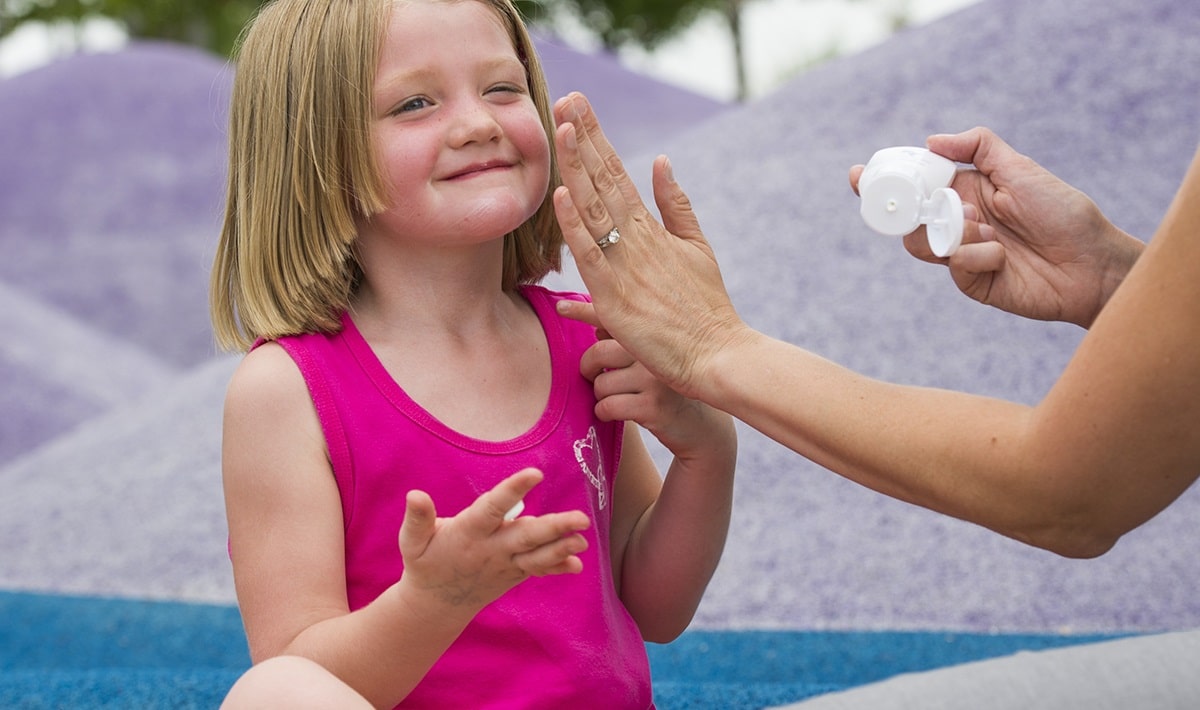Nobody likes a sunburn, and at 5280 feet, the sun affects you more than you know. The good news is, you can protect yourself and your children by using sunscreen. The bad news is, there are so many products on that market that it is hard to know which ones actually work and what ones contain harmful chemicals. Let's breakdown sun safety guidelines and the best practices for sunscreen use with Children’s Hospital Colorado dermatologist Anna Bruckner, MD.
Some people don’t take sun protection seriously until they’re already nursing a painful sunburn. But the redness, blistering and peeling aren’t just uncomfortable symptoms — they're signs of serious skin damage.
Learning the importance of proper sun safety can help prevent the unpleasant and potentially dangerous effects of too much sun, keeping your child’s skin healthy for years to come.
Whether it’s choosing the right sunscreen, reapplying after swimming or treating a sunburn, Children’s Hospital Colorado dermatologist Anna Bruckner, MD, shares the best sunscreen tips for kids of all ages.
How to choose the best sunscreen for kids
Sunscreen protects against ultraviolet light from the sun, which can damage skin at the DNA level. Our bodies are well equipped to repair such damage in small amounts, but too many sunburns over time can cause problems.
“Studies have definitely shown that people who tend to have more sunburns are at higher risk of developing skin cancers down the road,” Dr. Bruckner says. “That's why when you're getting a lot of sunburns, it's a sign that you're getting too much damage or injury to your skin.”
Sun safety means minimizing the cumulative skin damage that can happen over time as we age, and protection starts with proper sunscreen use in childhood.
Sunscreen vs. mineral sunblock
The first step in choosing the best sunscreen for kids is understanding the difference between sunscreen and sunblock. Sunblock contains zinc oxide or titanium dioxide — minerals that physically block the sun’s rays by scattering ultraviolet radiation. In contrast, sunscreen uses chemicals to absorb ultraviolet (UV) radiation.
Either way, caregivers should look for sunblock or sunscreen that has a sun protection factor (SPF) of at least 30 or higher. You’ll also want to find broad-spectrum sunblock or sunscreen, which will protect against both ultraviolet A (UVA) and ultraviolet B (UVB) rays. UVA rays are associated with skin aging, while UVB rays cause sunburn.
For athletics, outdoor activities or other situations where your child may be swimming or sweating, consider water-resistant sunscreen or sunblock. Because both sunscreen and sunblock have beneficial qualities, you may find the best protection by using a product that contains the best of both worlds. Specifically, consider a UVB chemical sunscreen that includes a physical sunblock ingredient, like zinc or titanium, as well as a higher SPF and broad-spectrum coverage.
Do kids need a different kind of sunscreen?
Sunscreen labeled for babies and kids often has the same active ingredients as adult versions, but in cuter packaging. Your child won’t be more protected with a "baby" SPF 30 sunscreen than with a "regular" SPF 30 sunscreen if both have the same active ingredients.
For kids under 6 months old, follow sun-safe practices rather than using sunscreen. For instance, keep your child out of the sun by covering their body in clothing, light blankets and hats. A stroller with a hood is also important. At 6 months of age, you can start protecting your child with sunscreen. Start by testing a small patch on their skin to make sure they don’t develop a rash or other reaction.
What is clean sunscreen?
“Clean” isn’t an official label for sunscreen; however, the idea of clean sunscreen refers to products that don’t contain harmful chemicals.
The most dangerous sunscreen ingredient is benzene, a toxic chemical derived from petroleum that’s also found in tobacco smoke, vehicle exhaust and industrial emissions. Benzene has been found in aerosol or spray sunscreens, many of which have been recalled.
Given this, you may want to avoid spray sunscreen and choose a lotion-based sunblock or sunscreen verified by the Environmental Working Group, a nonprofit that reviews sunscreen and other personal care products for potentially harmful ingredients.
Sunscreen labeled as being “clean” may also be better suited for infants and children with sensitive skin.
Spray sunscreen vs. lotion
Aside from the risk of benzene exposure, chemical sunscreen in a spray bottle can irritate nasal passages and enter the mouth and eyes when sprayed on the face. Additionally, since chemical sunscreens in either spray or lotion form can burn the eyes if a child is swimming or sweating, kids with sensitive skin and eyes may do better with sunblock lotion that has only zinc oxide or titanium oxide.
Sunscreen safety tips
Applying sunscreen is an important first step toward sun protection, but you have to use it properly to receive its full protective benefits.
How long can you be outside without sunscreen?
The American Academy of Dermatology recommends always using sunscreen and other sun protective measures, such as hats and sunglasses, when playing outdoors, even during the winter months.
However, avoiding the sun entirely can lead to a vitamin D deficiency. UVB rays enter exposed skin and create vitamin D, which serves a crucial role in aiding the absorption of calcium and promoting strong bones. Adequate levels of calcium are critical for other important processes in our bodies, such as hormone levels, nerve conduction and muscle contraction.
So how can you find the right balance between getting enough vitamin D and staying safe in the sun? Spending a few minutes at a time in indirect sunlight before 10 a.m. or after 4 p.m. is considered safe.
“If you're going out and doing errands where you might be going from your car to the store, and you're just outside a few minutes intermittently, you probably don't need to be slathering up with sunscreen from head to toe,” Dr. Bruckner says.
When it comes to kids in cars, however, keep in mind that UVA rays can still cause damage if they reach your skin through windows. Windows in the backseat of a car may not be designed to filter UVA rays because it isn’t required by law. A UV shield or window screen can help block these rays while still allowing your child to benefit from sunlight.
In general, however, if you’re going to spend more than a few minutes in direct sunlight, you should be wearing sunscreen. This is especially true for areas such as our faces and hands, which are the most exposed.
How much sunscreen should you apply, and when should you apply it?
Most people apply only half the amount of sunscreen recommended, and not evenly. This decreases the SPF power and allows uncovered areas to burn. Follow these tips for applying sunscreen correctly:
- You should use about an ounce, or the size of a medicine cup, to cover the exposed parts of your body.
- Apply sunscreen evenly to skin while you’re indoors, preferably before dressing, and at least 15 to 30 minutes before going out in the sun.
- Be sure to reapply every one to two hours, or sooner if you swim, sweat profusely or towel off.
- Water-resistant sunscreens are labeled to last 40 or 80 minutes, and for a day at the beach, one person should go through about two to four ounces of sunscreen.
How can you teach kids sun safety?
The good sun habits you teach now can keep kids healthy throughout their lifetime. One way to promote the importance of sunscreen is to make it a daily habit, like brushing teeth. Put sunscreen on your child every morning before they leave the house. Your child may want to practice applying sunscreen themselves, but you should watch to make sure they do a good job and help fill in any places they miss.
Sunscreen and sunblock are just one line of defense against the sun, and they do not protect against 100% of harmful UVB and UVA rays. Therefore, sunscreen should be a part of a total sun protection routine that includes hats, protective clothing and sunglasses. Pack these items in your child’s backpack if they’re going to be outside and remind your kids to use them daily.
Teenagers can start using sunscreen themselves on a regular basis. "For older kids, using a light moisturizer with a mild facial sunscreen is a good idea to keep the most exposed areas of their skin protected,” Dr. Bruckner says.
Most of all, talk to your child about how important it is to protect their skin from the sun, and start these conversations early.
Can you use expired sunscreen?
Like other personal care products, Dr. Brucker says that sunscreen has a shelf life. “There is a chance that some of those ingredients might be less effective after a period of time, so it’s worthwhile to follow the recommended lifecycle of the product and avoid using it beyond the expiration date.”
If your sunscreen becomes clumpy or separated before the expiration date, that could be a sign that its components have broken down and become less effective. In that case, it’s time to replace it.
How do you treat a sunburn in kids?
If your child is sunburned, get them out of the sun as soon as possible and keep them cool with a bath or cold towels. Use after-sun lotion that contains aloe vera and other natural moisturizers. Try to avoid products with petroleum jelly, as these can trap heat in the skin when your goal is to lower body temperature. Lastly, make sure your child stays hydrated and rests. Keep a close eye on your child and if they develop nausea, dizziness, cramps or other signs of heatstroke, call your doctor.

